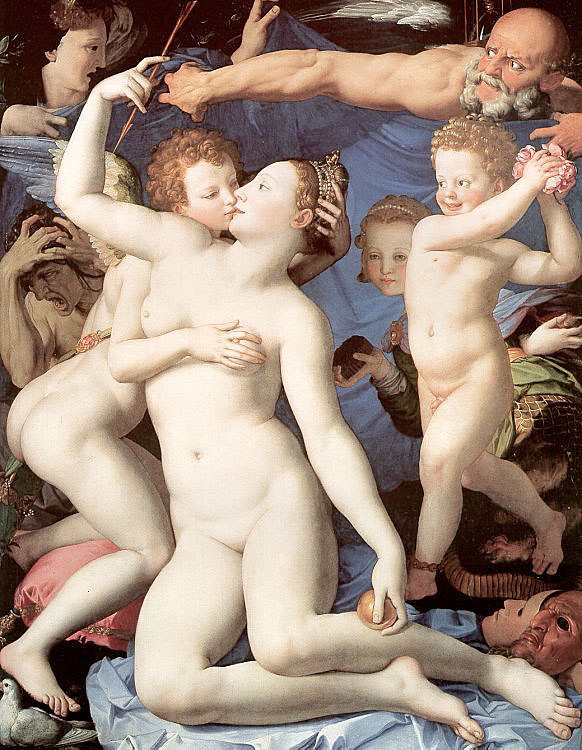Bronzino - The allegory of lust “Venus, Cupid, Time and Folly”
 Agnolo Tori, called Bronzino, born in 1503, was in Pontorno’s studio from childhood, and from 1539 onwards was the chief court painter to the Medici ruler, Cosimo I, and his wife Eleanora of Toledo. For her he decorated the chapel in the Palazzo Vecchio, with frescoes of astonishing incoherence and fantastic colour, filled with the usual Mannesrist conception of men in extreme foreshortenings and exaggerated musculature, and women of the most pallid and coldly classical beauty. The allegory of lust “Venus, Cupid, Time and Folly”, painted in 1545, was probably created at the Tuscan court of Duke Cosimo de' Medici for presentation to the King of France Francis I. This work is of a rebarbatively frigid eroticism. It was designed as a puzzle, and incorporates symbols and devices from the worlds of mythology and emblematic imagery. It would have made the perfect present for the French king, known for his lusty appetites, yearning after Italian culture and magnificence, and with a liking for heraldry and obscure emblems. The allegory of lust displays the ambivalence of the Mannerist period in life and art. It also illustrates the Mannerist taste for obscure imagery with erotic overtones.
Agnolo Tori, called Bronzino, born in 1503, was in Pontorno’s studio from childhood, and from 1539 onwards was the chief court painter to the Medici ruler, Cosimo I, and his wife Eleanora of Toledo. For her he decorated the chapel in the Palazzo Vecchio, with frescoes of astonishing incoherence and fantastic colour, filled with the usual Mannesrist conception of men in extreme foreshortenings and exaggerated musculature, and women of the most pallid and coldly classical beauty. The allegory of lust “Venus, Cupid, Time and Folly”, painted in 1545, was probably created at the Tuscan court of Duke Cosimo de' Medici for presentation to the King of France Francis I. This work is of a rebarbatively frigid eroticism. It was designed as a puzzle, and incorporates symbols and devices from the worlds of mythology and emblematic imagery. It would have made the perfect present for the French king, known for his lusty appetites, yearning after Italian culture and magnificence, and with a liking for heraldry and obscure emblems. The allegory of lust displays the ambivalence of the Mannerist period in life and art. It also illustrates the Mannerist taste for obscure imagery with erotic overtones.The attention to silky textures, jewels, and masks is consistent with Bronzino's courtly, aristocratic patronage. The figure of Venus appears as a precious object in a luxurious setting, perversely seductive by virtue of her very unapproachability.
Crowded into a compressed foreground space of the airless setting are several figures whose identities and purpose have been the subject of extensive scholarly discussion. The painting appears to be about lust, fraud, and envy. It has also been called a "Triumph of Venus". Its meaning, however, remains elusive.
Venus The goddess of love and beauty, entangled in an incestuous act, identified by the golden apple given to her by Paris and by her doves, has drawn Cupid's arrow, who fondles his mother's breast and kisses her lips. At her feet, masks, perhaps the symbols of sensual nymph and satyr, seem to gaze up at the lovers. To the right, foolish pleasure, the laughing nude putto with a lascivious expression dances forward and scatters flowers at them, heedless of the thorn piercing his right foot. Behind him Deceit, fair of face, but foul of body, proffers a sweet honeycomb in one hand, concealing the sting in her tail with the other. On the other side of the lovers is a dark figure, formerly called Jealousy but recently plausibly identified as the personification of Syphilis, a disease probably introduced to Europe from the New World and reaching epidemic proportions by 1500.
Bald, bearded Time at the upper right, assisted by Oblivion at the upper left, draws aside a curtain to reveal the incestuous transgressions of Venus and the adolescent Cupid.
The symbolic meaning of the central scene is thus revealed to be unchaste love, presided over by Pleasure and abetted by Deceit, and its painful consequences. Oblivion, the figure on the upper left who is shown without physical capacity for remembering, attempts to draw a veil over all, but is prevented by Father Time - possibly alluding to the delayed effects of syphilis. Cold as marble or enamel, the nudes are deployed against the costliest ultramarine blue, and the whole composition, flattened against the picture plane, recalls Bronzino's contemporaneous designs for the duke's new tapestry factories.



3 Comments:
Several characters in the second volume of Robertson Davies' Cornish Trilogy, which concerns itself with art among many other themes, also extensively debate the meaning of this painting.
In this painting, Bronzino is at his most lucid. The flesh tones are among the most gorgeously erotic in painting, set against the sumptious background of precious Lapis blue.
The beautiful, most 'womanly', Venus is clearly enticing an innocent adolescent old enough to appreciate her seductive loveliness.
Could a woman see Cupid as a messenger of her own destruction at the hand of a man, a discarded lover, a cheated wife? Venus, here, is taking control of Cupid, grasping his arrow. She is taking male sexuality, that of her own son, and therefore under her total control, thereby satiating her desire without loosing control of her destiny!
Perhaps the most delicous seduction in painting is presented to us as a moment in time, shielded by the image of Time holding the veil, while we get a concurent and powerful warning from the anguished figure of real Motherhood, outside the veil, on Venus' left.
Bronzino is temting the viewer to let 'Gay Abandon' rule the day, by showing Venus with petals of rose.
This must be one of the most errudite of Mannerist paintings, too good for his Court of Lesser Mortals, Cosimo saw this picture fit for a King!
Interpretations of this painting seem always to omit firstly, that Venus is offering Cupid the kiss (not the other way about), it is her tongue which is proceeding towards the recipient's lips. Secondly, that She is graspng the dart from his quivver.
This fabulously beautiful woman is, therefore, initiating the power of love, not, as was the usual form, a recipient of Cupidty. Perhaps a woman might want to accept male sexuality in a manner of her own choosing, without the risk being either being forsaken or betrayed.
But Venus is the mother of Cupid, and, a son is the only male sexuality over which a woman has complete mastery! In the context of this picture, then, Venus is lusciously sexual, her brilliant flesh and lithe body leaving the viewer in no doubt as to the reality of her sexuality. She expresses the power of her sexuality over that of Cupid by grasping his dart and initiating an overtly sexual kiss.
This is a momentary physical act, and is therefore separated from the rest of existance by the curtain of Time.
Folly, naturally comments by his presence in the same picture plane as the principal figures. Then there is the face of a pretty young girl, cross handed, she holds out the taste of honey while retaing the sting of a serpent - Bronzino is seriously 'even handed'!
What then of the much ridiculed face to the left of cupid, yet outside the veil of time? She is not either syphilitic or jealous, she is the face of outraged motherhood!
This picture takes the physical art of the Mannerists into the realm of psycho- sexual dynamics. A virtuoso piece that was capable of projecting the power of Venetian taste well beyond its own borders!
Post a Comment
<< Home